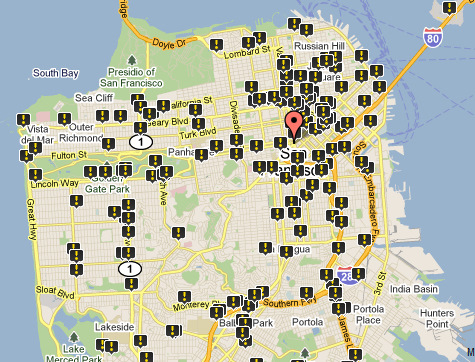It's no secret that San Francisco could do a lot more to make its streets safer, but a new national report on pedestrian safety issued today highlights a glaring pattern where the bulk of preventable pedestrian crashes with motor vehicles occur: on poorly designed, high-speed "arterial" roads.
San Francisco is renowned for being a walkable city but still has its share of dangerously designed streets that put pedestrians most at risk from cars.
"In urban areas, nearly 60 percent of pedestrian fatalities occur on wider, high-capacity, and higher-speed roads called 'arterials'," said Michelle Ernst, co-author of "Dangerous by Design," a new comprehensive report on the state of pedestrian safety from Transportation for America.
Across the state and the nation, most pedestrian deaths are shown to occur on roads designed for high vehicle speeds with poor pedestrian facilities, and the victims are disproportionately comprised of seniors and people of color. The problem has been historically ignored by governments at all levels.
"If a jumbo jet crashed in this country every month, which is about the equivalent of what happens with pedestrian fatalities, you would be sure there would be no end to congressional hearings and investigations," said James Corless, the director of Transportation for America.
In San Francisco, the trends are no different. As Streetsblog has reported, District 6 bears the greatest proportion of the city's pedestrian crashes. The increasingly populated area is cursed with wide, one-way roads that act effectively as extensions of the 280 freeway, imposing some of the city's most dangerous conditions along with other car traffic sewers like Masonic Avenue. The district also houses a significant portion of the city's poorest residents.
"The report highlights that in San Francisco, as in the entire country, arterial streets are deadly, speed kills, and that relatively small investments in pedestrian improvements to our streets make neighborhoods in our city much safer, more pleasant places to walk," said Walk SF Executive Director Elizabeth Stampe.
People walking on the streets account for 51.9 percent of all traffic fatalities in San Francisco, says the report, ranking it the 7th highest county in California for pedestrian deaths per population. Out of the city's 11 districts, 31 percent of those deaths last year took place in District 6 alone. Even as speed limits are lowered, many of the city's streets feature designs that encourage drivers to speed.
“You should be able to walk safely in your neighborhood, whether you live in Pacific Heights or in a residential hotel on Sixth Street,” said D6 Supervisor Jane Kim. “It’s an issue of equity."
"I think we need to be looking for a vaccine type of approach where our policies can be prescriptive and progressive," said Dr. Tony DeLucia, professor of environmental health at East Tennessee State University. "Otherwise, we're just rearranging the deck chairs on the Titanic."





